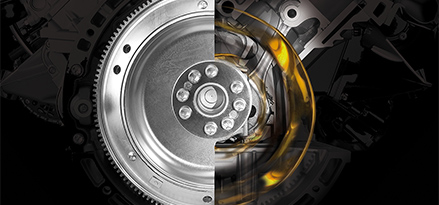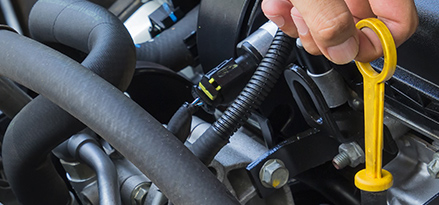Motor oil breaks down over time. When it breaks down, it loses its effectiveness and can no longer properly protect your engine.
In addition to lubricating an engine's moving parts, motor oil is designed to carry combustion by-products away from the pistons and cylinders. It is designed to deal with the small amounts of water that form as the engine heats and cools, and to collect the dirt and dust that enter the engine through the air-intake system. It also handles acids that are formed by the reaction between water and other contaminants. Sometimes there are even fuel leaks (fuel dilution) or coolant leaks that get into the oil system.
As a car is driven, the level of contamination in the motor oil constantly increases. The oil filter removes particles as the oil passes through the filter, but over time, an oil's additives are used up and the oil itself can start to degrade (oxidize or thicken). At that point, the oil can no longer do its job and must be changed.
The rate at which contamination and additive depletion occurs depends on many variables. One of these is driving conditions, which vary greatly and have a direct effect on the useful life of the oil. Other factors include the precision of ignition, fuel injection or carburetion adjustments, air cleaner service and the general mechanical condition of the engine.
Oil should be changed before the contamination level reaches the point where engine damage can result. Because it is difficult for the individual motorist to determine when the contamination level is too high, automobile manufacturers provide recommended oil change intervals. These change recommendations vary by model year and manufacturer. Recommended intervals and mileage limits also vary with the type of service under which a car operates. More frequent oil changes are recommended for severe service.
In addition to lubricating an engine's moving parts, motor oil is designed to carry combustion by-products away from the pistons and cylinders. It is designed to deal with the small amounts of water that form as the engine heats and cools, and to collect the dirt and dust that enter the engine through the air-intake system. It also handles acids that are formed by the reaction between water and other contaminants. Sometimes there are even fuel leaks (fuel dilution) or coolant leaks that get into the oil system.
As a car is driven, the level of contamination in the motor oil constantly increases. The oil filter removes particles as the oil passes through the filter, but over time, an oil's additives are used up and the oil itself can start to degrade (oxidize or thicken). At that point, the oil can no longer do its job and must be changed.
The rate at which contamination and additive depletion occurs depends on many variables. One of these is driving conditions, which vary greatly and have a direct effect on the useful life of the oil. Other factors include the precision of ignition, fuel injection or carburetion adjustments, air cleaner service and the general mechanical condition of the engine.
Oil should be changed before the contamination level reaches the point where engine damage can result. Because it is difficult for the individual motorist to determine when the contamination level is too high, automobile manufacturers provide recommended oil change intervals. These change recommendations vary by model year and manufacturer. Recommended intervals and mileage limits also vary with the type of service under which a car operates. More frequent oil changes are recommended for severe service.
Engineers work to establish an optimal viscosity for an oil, based on load and speed conditions. They balance lighter – or low-viscosity – oil, which provides little resistance to motion thereby saving fuel and efficiently transferring horsepower, with a heavier – or high-viscosity – oil that resists being squeezed out of the contact area between metal surfaces.
The complicating factor is that the viscosity of an oil varies with changes in temperature – thinner when hot, thicker when cold. At low temperatures, we need the motor oil to flow readily (not thicken too much or gel). At high temperatures, we need the motor oil to keep from becoming too thin and allowing metal-to-metal contact. Therefore, engineers developed multigrade motor oils.
The complicating factor is that the viscosity of an oil varies with changes in temperature – thinner when hot, thicker when cold. At low temperatures, we need the motor oil to flow readily (not thicken too much or gel). At high temperatures, we need the motor oil to keep from becoming too thin and allowing metal-to-metal contact. Therefore, engineers developed multigrade motor oils.
Viscosity is a measure of a fluid's resistance to flow. A fluid with low viscosity flows easily and is often called "thin" Water is an example of a fluid with a relatively low viscosity. A fluid with high viscosity is often described as "thick" Maple syrup is an example of a fluid with a relatively high viscosity.
If the cloud is relatively blue or blue/black, it may indicate that oil is being burned along with the fuel. The possible cause may be either worn piston rings or an oil viscosity that is too low.
If the cloud is black, it indicates that excess fuel is being burned.
If the cloud is white, it may simply be the moisture in the cold engine and exhaust system being burned off. If there's a lot of white smoke and it continues for a long time, you may have an internal coolant leak.
If the cloud is black, it indicates that excess fuel is being burned.
If the cloud is white, it may simply be the moisture in the cold engine and exhaust system being burned off. If there's a lot of white smoke and it continues for a long time, you may have an internal coolant leak.
Engine oils are currently classified by a two-letter code. Gasoline engine oil categories start with the letter S (originally designated "Spark Ignition" engine oils, we now associate the S with "Service"). Diesel engine oil categories start with the letter C (originally designated "Compression Ignition" engine oils, we now associate the C with "Commercial").
The second letter is simply a sequential designation of improving quality levels over time. In other words, when a new industry quality level is established, the next letter of the alphabet is used (so SJ replaces SH). The letters "I" and "K" were purposefully skipped to eliminate potential confusion with other commonly used designations.
The second letter is simply a sequential designation of improving quality levels over time. In other words, when a new industry quality level is established, the next letter of the alphabet is used (so SJ replaces SH). The letters "I" and "K" were purposefully skipped to eliminate potential confusion with other commonly used designations.
The viscosity index (VI) number is a measure of the relative change in viscosity of oil over a temperature range. The HIGHER the viscosity index, the SMALLER the viscosity change over temperature. The VI is not related to the actual viscosity or SAE viscosity, but is a measure of the rate of viscosity change.
The VI number is typically used only as an indicator. The actual performance results of low-temperature pumpability tests and high-temperature wear tests of a motor oil are better predictors of good performance in an engine.
Generally, multigrade oils (0W-40, 10W-30, etc.) will have high viscosity indexes. Monograde oils (SAE 30, 40, etc.) will have lower viscosity indexes.
The VI number is typically used only as an indicator. The actual performance results of low-temperature pumpability tests and high-temperature wear tests of a motor oil are better predictors of good performance in an engine.
Generally, multigrade oils (0W-40, 10W-30, etc.) will have high viscosity indexes. Monograde oils (SAE 30, 40, etc.) will have lower viscosity indexes.
Your oil warning light can come on for a number of reasons including: low oil level, a failing oil pump, a faulty oil-pressure sensor, blockage in the oil system, excessive foaming of the oil and more. In all cases, you should shut down your engine as quickly as it is safe to do so. Continuing to operate your engine with low oil pressure can result in serious engine.
-

Car engine oil explained
Checking your oil regularly is important and can help prevent excess engine wear.
Learn more -

How to change your oil and oil filter
Frequent oil and filter changes are essential in helping your car and its performance.
Learn more -

Car care and driving tips
The heat of midsummer and the ice of a deep winter put different stresses on wheels and engines – but the same components still need to work smoothly, efficiently and safely.
Learn more




